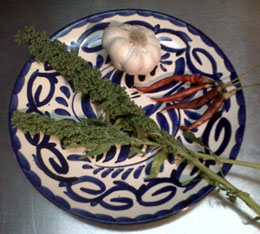
The year was 1987, and the walk through the Cholula tianguis, or outdoor street market, was our first. In those days, we were unfamiliar with so much of the produce, and our comments that day on the “crazy looking Mexican broccoli” were directed at huazontle, a green having little to do with broccoli except the appearance of similar small round clusters at the plant’s tips. More about huazontle (pronounced wah-SONT-lay and sometimes spelled huauzontle or guazontle) later, but first a look at Mexico’s tianguis, and why some of the freshest and most local produce is found at them, and not in the municipal markets.
While the indoor municipal market, with some surrounding outside stalls, is open daily, the tianguis is usually held once or twice a week (in Cholula it’s Sunday and Wednesday) and it is here that the greatest variety of produce can usually be spotted. While it is true that a lot of the produce sold at the tianguis comes from a central de abastos, one of the country’s huge regional markets, the only chance local produce stands to be sold locally is at the tianguis.
The reason for all this dates back to Mexico’s colonial period, specifically to the Spanish abastos (“supply” or “source”) system, designed to regulate the trade of basic foods by distributing them through central markets, where they are sold at wholesale prices, then resold at local markets. This is why the fragrant truckloads of green onions that pass through the streets of Cholula from fields just outside town are not headed for the Cholula market, but to a central de abastos, from which they’ll travel to markets in six different states.
The tianguis, named for the Nahuatl word for awning, used since pre-Hispanic times to designate these open air markets, do not have to sell products bought at a central de abastos. The prime spots near the municipal market are more likely to have products bought at abastos, while a few blocks further away, indigenous women from surrounding areas are selling things that have been grown in their own gardens and milpas (corn fields.)
They will usually have the freshest crops of beans and the least chemically treated produce. Women from the villages near Popcatepetl will have molcajetes and tejolotes (mortars and pestles) made from volcanic stone, and others will have fruit, cosmetically unattractive but intensely flavorful, from local orchards. There will be red, blue, green, yellow and white dried corn kernels ready to be taken home and made into masa (corn dough) and huge calabazas, the pumpkin-like squash that rural Mexicans store on the roof, to be used for their seeds, to make the roasted seeds called pepitas or the seed and chile sauce called pipian. There will be several types of herbs and greens that are inexpensive, nutritious and prepared in tasty ways created by people who have a long tradition of eating them. And this brings us back to huazontle.
This Mexican native plant, sometimes called “Aztec spinach,” actually does resemble an elongated broccoli. A member of the chenopodium family, it is related to amaranth and quinoa, with clusters of flower buds that are eaten before the buds begin to open and bloom. Its tough stalks are cut off close to the bud and, when used to make batter-dipped huazontle, used as “handles” to eat something that resembles a chile relleno.
Huazontle is inexpensive, grows easily from seed, and is a low maintenance and high yield plant. It is easy to see why it has been an important vegetable in Mexico for so long, and the highlight of many meatless meals. However, we didn’t buy it or know what to do with it until a Mexican friend brought the ingredients for cheese stuffed huazontle to our house and showed me how to cook it.
The huazontle bud clusters were cut from the stems, leaving a few inches of stem, which we held to eat it. The vegetable was steamed, then stuffed with Oaxaca cheese that Lourdes pushed into the clusters. She squeezed each bunch to hold it together, then dipped it in batter and fried it.
A few years after that cooking lesson, I had a more sophisticated version at a high end restaurant, where the buds were removed from the stems completely and made into croquettes. This was a less informal way to prepare the vegetable (no sucking the last bits of food while holding the stems) but it was far less messy to eat, and didn’t leave behind strings of what look like green dental floss.
Both versions are delicious, and traditionally served with tomato or pasilla chile sauce. In the Yucatan, huazontle tops are boiled, cooled and mixed with cooked, cooled and sliced new potatoes, dressed with a vinaigrette and served as a salad.
Nutritionally, huazontle and other chenopodium are important elements in a corn based diet, providing essential amino acids that corn is lacking. Huazontle is high in fiber and protein, as well as calcium, iron, potassium, phosphorus and vitamins A and C.
North of the border, the culinary emphasis on new tastes and textures means that huazontle is often found at farmers markets and Mexican grocery stores. For those interested in growing it, seeds are available online at www.seedsofchange.com , www.marketworks.com and https://b-and-t-world-seeds.com Huazontle turns red if not harvested while green, although I’ve only seen it sold green at the tianguis.
The following recipes all call for the huazontle to be boiled or steamed before further preparation. Always wash huazontle thoroughly before using. The huazontle croquettes and the huazontle tart both make good vegetarian main dishes.
- Huazontle croquettes: Tortitas de huazontle
- Huazontle tart with pasilla chile: Tarta de huazontle con chile pasilla
- Cumin flavored huazontle with onions: Huazontle con cebollas y comino


